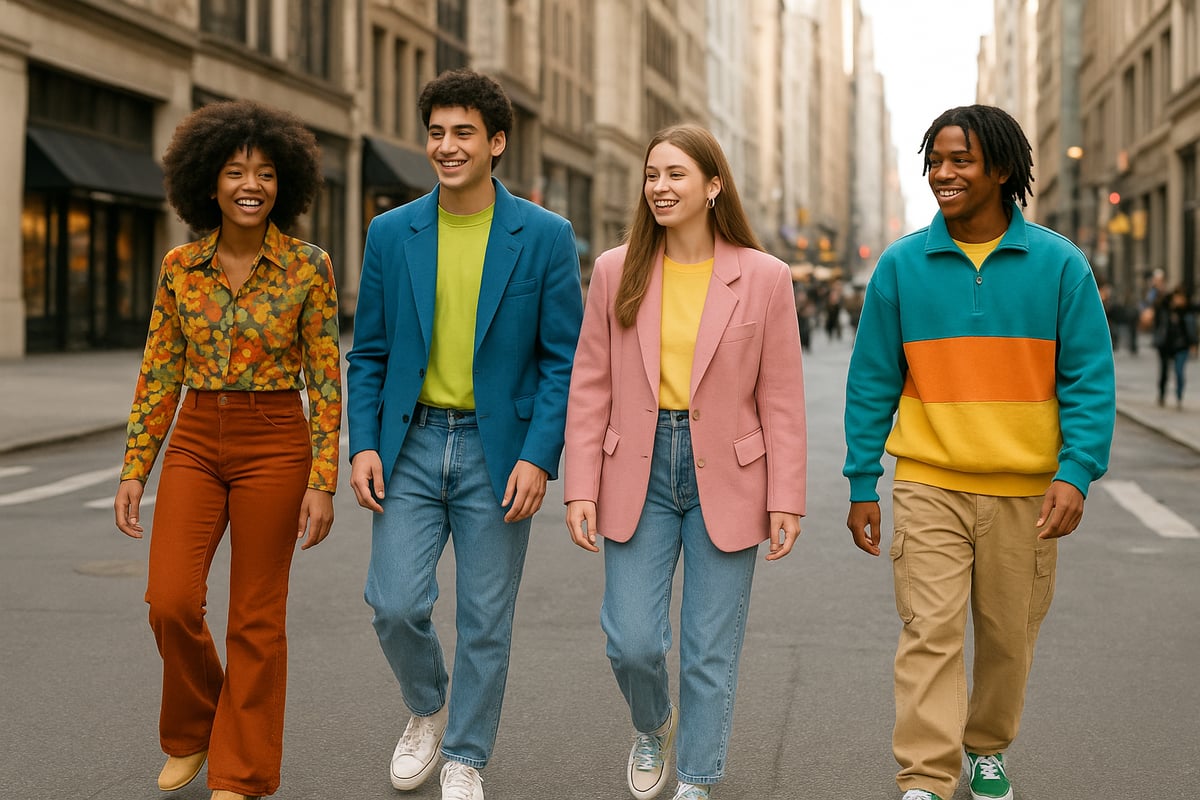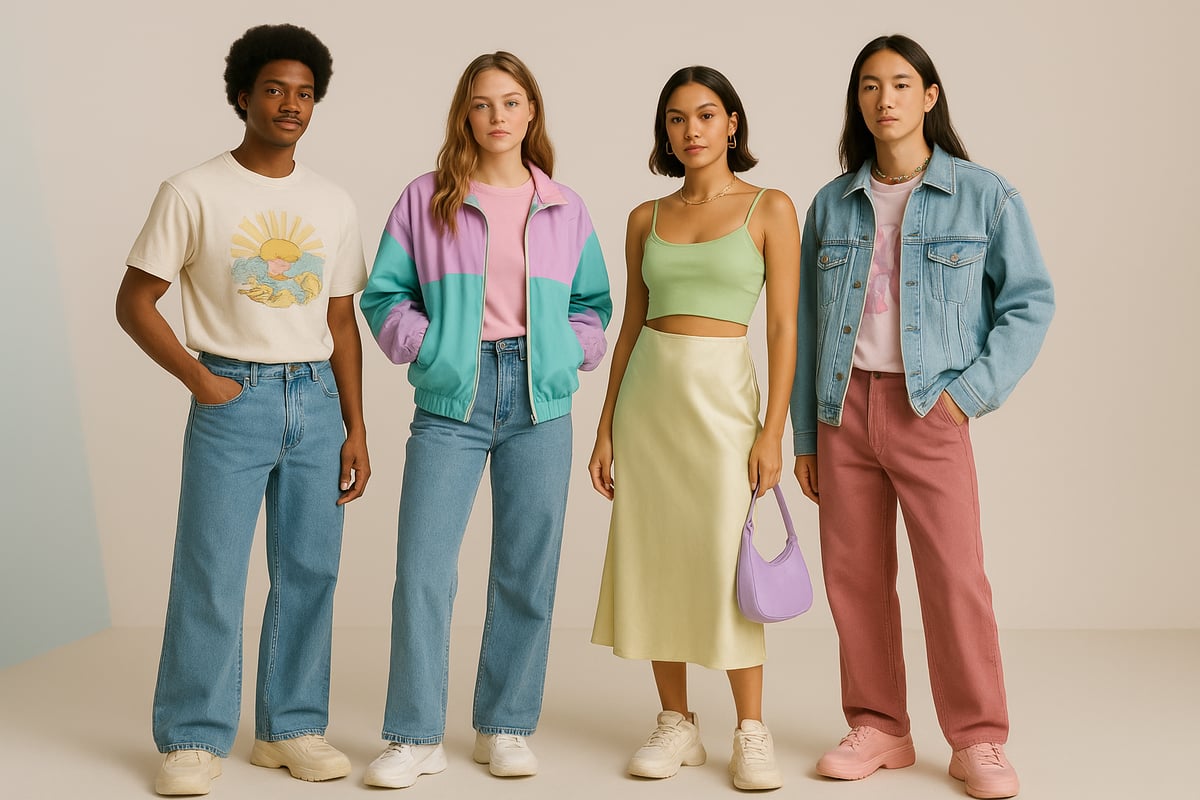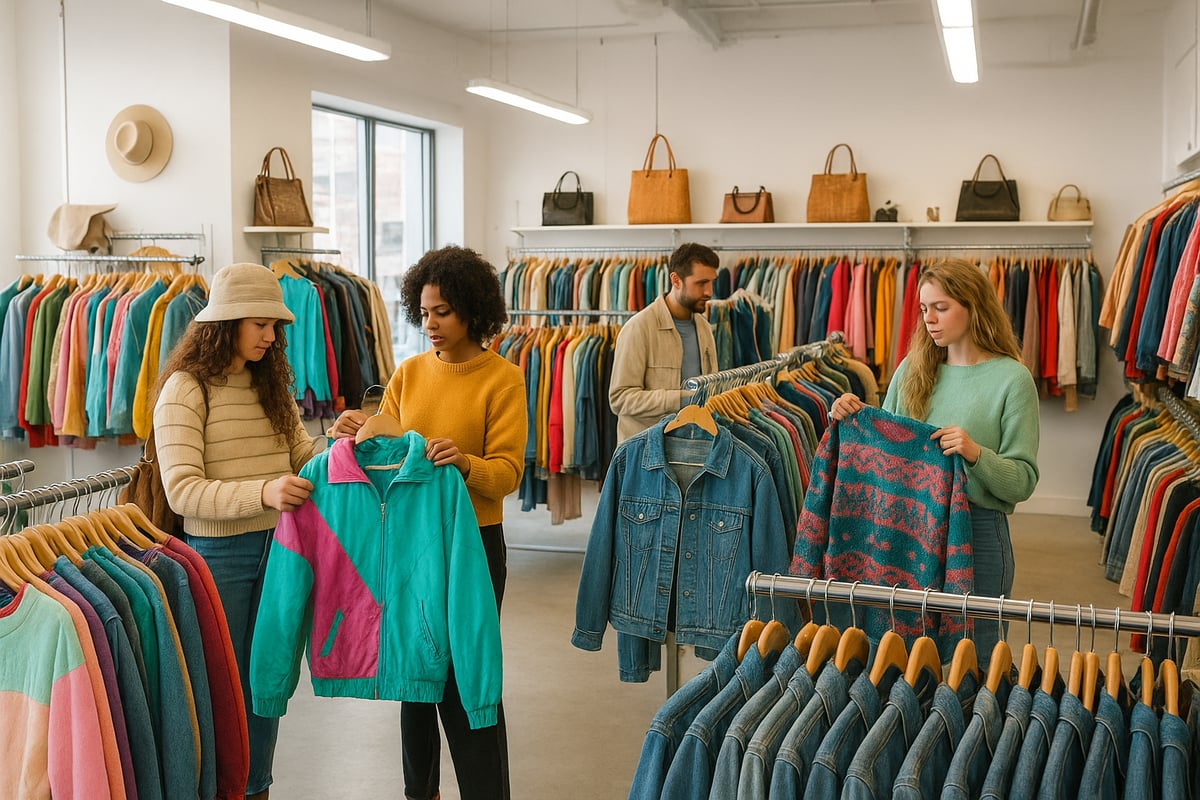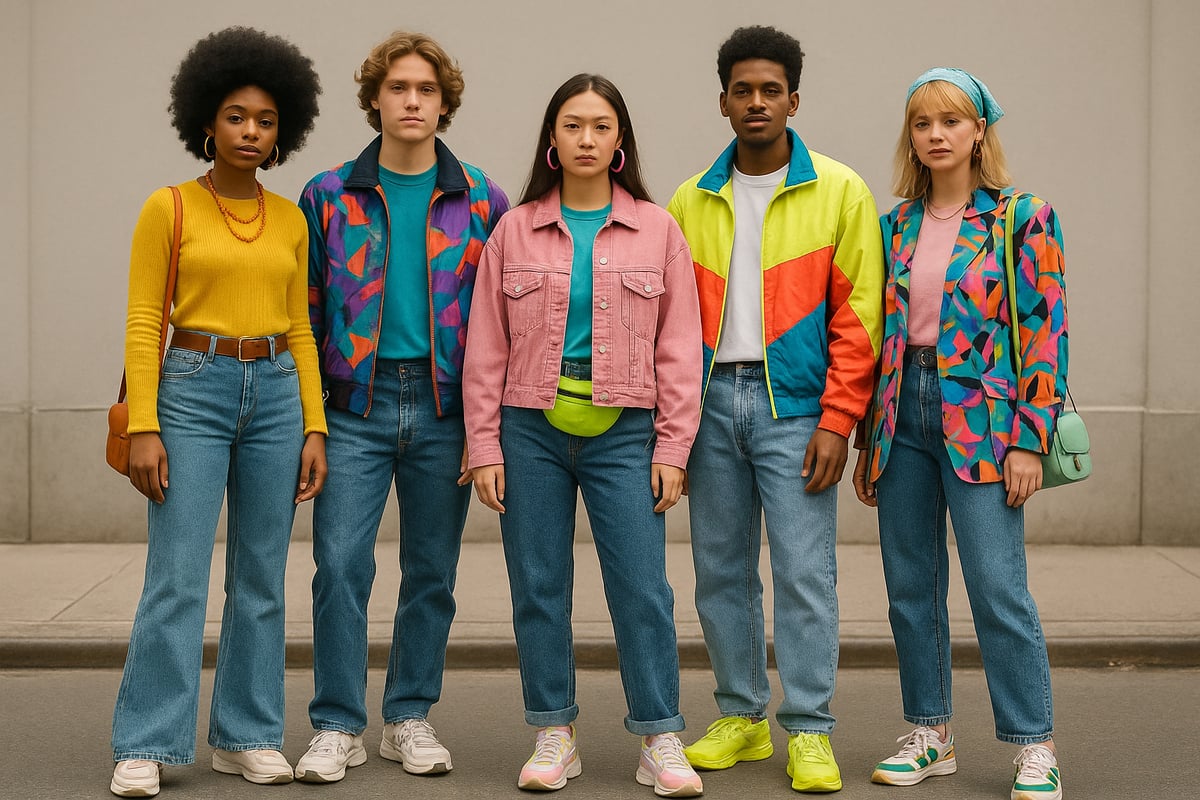Step confidently into 2025 as retro clothing redefines the fashion landscape, merging nostalgia with fresh contemporary energy. This growing passion for vintage-inspired style reflects not only a love for timeless design but also a commitment to more sustainable choices. Are you ready to build a wardrobe that stands out and tells your unique story? In this guide, you will discover what defines retro style, essential pieces for your closet, smart shopping tips, expert styling advice, and the best ways to care for your favorite finds.
What Defines Retro Clothing in 2025?
Retro clothing in 2025 is a vibrant blend of nostalgia and innovation. This style draws inspiration from decades past while adapting to the current era, making it both relevant and timeless. Understanding what sets retro clothing apart is essential for anyone looking to embrace this trend with confidence.

Key Characteristics of Retro Style
Retro clothing in 2025 takes cues from the 70s, 80s, 90s, and early 2000s. Signature features include wide-legged pants, oversized blazers, and bold graphic prints. Fabrics such as corduroy, denim, and synthetics are common, often in color palettes that range from earthy browns to neon brights.
Fashion shows have highlighted the comeback of flared pants and statement jackets. Celebrities are seen mixing checkerboard patterns with pastel shades. The main distinction is that authentic vintage pieces are original items from past decades, while retro clothing often refers to modern reproductions inspired by those styles.
Why Retro Fashion is Trending Now
Several cultural factors are fueling the popularity of retro clothing. Nostalgia plays a big role, as people seek comfort and identity through familiar aesthetics. Sustainability is another driver, as shoppers look for ways to minimize waste. According to Google Trends, searches for “retro clothing” rose by 40% from 2023 to 2024.
Gen Z and Millennials lead this movement, often sharing their looks on TikTok and Instagram. Social platforms have made it easier to discover and share vintage-inspired outfits. For more on this trend’s cultural roots, see Why Is Vintage Shopping Popular.
Retro vs. Vintage: Understanding the Terminology
It is important to distinguish between retro clothing and vintage apparel. Retro refers to new garments designed to mimic past styles, while vintage means authentic pieces that are over 20 years old. Retro clothing offers accessibility and modern sizing, making it easier for more people to participate.
Below is a quick comparison:
| Feature | Retro Clothing | Vintage Clothing |
|---|---|---|
| Age | Modern production | Over 20 years old |
| Sizing | Modern fit | Original sizing |
| Availability | Widely available | Limited, unique |
| Value | Affordable | Collectible, variable |
Brands like Urban Outfitters focus on retro reproductions, while shops such as Beyond Retro specialize in authentic vintage finds.
The Role of Sustainability in Retro Fashion
Sustainability is at the heart of the retro clothing revival. By embracing secondhand and upcycled pieces, shoppers help reduce textile waste and promote circular fashion. ThredUp’s 2024 Resale Report predicts the secondhand market will reach $77 billion by 2025, highlighting the shift toward eco-conscious choices.
Many retro clothing brands incorporate organic cotton, recycled polyester, and other eco-friendly materials. Upcycling damaged items into new designs is an emerging trend, making retro clothing both stylish and responsible.
How Designers Are Reinventing Retro
Designers in 2025 are reinventing retro clothing through innovative collaborations and limited-edition capsule collections. Classic silhouettes are reimagined with gender-neutral cuts, technical fabrics, and unexpected color combinations.
Leading fashion houses have launched lines inspired by the 80s and 90s, while indie brands experiment with sustainable materials and unique prints. These efforts ensure that retro clothing remains dynamic, relevant, and appealing to a diverse audience.
Essential Retro Wardrobe Staples for 2025
Curating the perfect retro clothing wardrobe for 2025 means knowing which pieces truly define the era’s spirit. Whether you’re a longtime vintage enthusiast or just starting to explore, these essentials will set the foundation for bold, nostalgic style statements all year.

Must-Have Tops and Outerwear
Tops and outerwear are crucial when building a retro clothing wardrobe. In 2025, expect graphic tees with bold logos and nostalgic prints to dominate. Turtlenecks and fitted crop tops inspired by the 80s and 90s add versatility for layering.
Statement jackets are essential. Look for denim jackets with patches, bomber jackets with vibrant color-blocking, and oversized blazers with strong shoulders. These outerwear staples bring structure and visual interest to any outfit.
Color-blocked windbreakers and patterned shirts let you play with texture and silhouette. For extra flair, mix in varsity jackets or faux-fur coats. Retro clothing thrives on boldness, so embrace standout pieces that reflect your personality.
Iconic Bottoms: Jeans, Skirts, and More
Bottoms are the backbone of any retro clothing collection. High-waisted and wide-leg jeans channel the 70s and 90s, while corduroy pants add tactile appeal. Mini skirts in denim or leather offer a nod to Y2K style, which continues to influence trends thanks to Gen Z’s embrace of Y2K fashion resurgence among Gen Z.
Cargo pants and pleated trousers reappear in both casual and formal looks. Pairing these bottoms with modern tops keeps outfits fresh. When mixing cuts, balance volume—wide-leg jeans with fitted tops, or mini skirts with oversized sweaters.
Experiment with layering: try tights under skirts or socks peeking from pants. Retro clothing encourages creativity, so combine vintage and contemporary pieces for a look that’s uniquely yours.
Dresses and Jumpsuits: Feminine Retro Flair
Dresses and jumpsuits offer effortless style in any retro clothing lineup. The slip dress—iconic in the 90s—returns in silk or satin, perfect for layering over tees or under chunky cardigans. Wrap dresses and pinafores from the 70s deliver flattering, versatile options for day or night.
Jumpsuits and rompers appear in bold prints and vibrant colors. These one-piece wonders simplify outfit planning and can be styled up or down. For transitional weather, layer turtlenecks or long-sleeve tops underneath.
Try mixing prints or adding a denim jacket for a playful twist. Retro clothing in dress form is all about movement, comfort, and a hint of nostalgia.
Footwear: From Sneakers to Platforms
Footwear is a defining element of retro clothing. Platform shoes, chunky sneakers, and Mary Janes are making waves in 2025. Look for retro sneaker models from brands like Nike and Adidas, which continue to re-release archival designs with modern updates.
Boots—especially knee-high and Chelsea styles—add edge to dresses and skirts. Loafers with thick soles provide a smart, vintage-inspired option for both casual and office wear.
Mixing footwear styles with unexpected outfits keeps your look current. For example, pair platform sneakers with a slip dress or boots with wide-leg jeans. Retro clothing shines when shoes make a statement.
Accessories That Complete the Look
Accessories elevate any retro clothing ensemble. Bucket hats and scrunchies add playful touches reminiscent of the 90s and early 2000s. Oversized sunglasses and statement belts bring instant drama.
Fanny packs and crossbody bags blend practicality with style. Vintage-inspired jewelry, like chunky chains and charm bracelets, offers a finishing touch. Scarves and headbands add pops of color and pattern.
When accessorizing, choose one or two bold pieces to avoid overwhelming your outfit. Retro clothing allows for experimentation, so mix and match until you find your signature look.
Color Palettes and Patterns to Watch
Color and pattern choices define the mood of retro clothing in 2025. Neon brights are back, complemented by earthy tones and soft pastels. This range means you can create both eye-catching and subtle outfits.
Popular patterns include tie-dye, checkerboard, paisley, and animal prints. Recent runway collections showcase these motifs on everything from jackets to accessories. Mixing prints is encouraged, but balance with neutral basics to prevent clashing.
Use color strategically—pair a neon top with classic denim, or introduce a patterned scarf to a monochrome outfit. Retro clothing thrives on expressive, confident styling.
Layering and Mixing Eras
Layering is key for mastering retro clothing. Combine pieces from different decades: try a 70s-inspired blouse with 90s cargo pants, or an 80s blazer over a Y2K slip dress. This approach creates a modern, personalized look.
Balance is crucial. Offset bold prints with solid basics and avoid wearing too many statement items at once. When mixing eras, consider fit and proportion to maintain a cohesive silhouette.
Layering also extends wearability across seasons. Add tights, turtlenecks, or lightweight jackets as needed. Retro clothing invites you to rewrite the rules and showcase your unique style journey.
Where and How to Shop for Retro Clothing in 2025
Shopping for retro clothing in 2025 is both an adventure and a strategy. With more choices than ever, finding the right pieces means knowing where to look, what to look for, and how to make smart decisions for your style and budget.

Thrift Stores and Vintage Boutiques
Thrift stores and vintage boutiques remain the heart of the retro clothing hunt. These shops offer one of a kind treasures, from classic denim to rare graphic tees. Shopping in person lets you examine quality, fit, and authenticity up close.
To make the most of your visit, browse racks methodically, check for sales, and talk to staff about new arrivals. Local flea markets and charity shops can be goldmines for unique pieces. Popular thrift chains and specialty boutiques often rotate inventory, so regular visits pay off.
For more detailed advice on navigating these spaces and identifying authentic finds, see this guide on Where to Buy Vintage Clothing. Retro clothing from these sources is not only stylish but often more affordable and sustainable.
Online Marketplaces and Apps
If you prefer shopping from home, online marketplaces for retro clothing offer convenience and variety. Platforms like Depop, Poshmark, Etsy, and eBay let you search by decade, brand, or item type. Use filters to narrow your search and compare prices across sellers.
Always check seller ratings and reviews before purchasing. Look for clear photos and detailed descriptions, which help you judge authenticity and condition. According to Statista, online vintage sales increased by 30 percent year over year in 2024, reflecting growing demand for retro clothing.
These platforms also offer buyer protection and easy returns, making online shopping secure. Set alerts for favorite items, and act quickly when you spot a rare find.
Retro-Inspired Brands and Reproductions
Not all retro clothing is secondhand. Many brands now create retro inspired collections that blend vintage aesthetics with modern materials and sizing. Labels like Levi’s, Reformation, and Urban Outfitters are known for their faithful reproductions and frequent capsule collections.
Choosing between new and vintage pieces depends on your priorities. New retro clothing often offers updated fits and sustainable fabrics, while authentic vintage brings unique history. Many modern brands also embrace eco friendly practices, so you can support sustainability even with new purchases.
Explore different brands to find the right balance of authenticity, quality, and price for your wardrobe.
Shopping Tips for Finding Quality Pieces
Quality is crucial when selecting retro clothing. First, inspect the fabric for signs of wear or fading, and check seams and hems for durability. Authentic vintage often has older labels or unique construction details.
Sizing can be tricky, as vintage sizes differ from today’s standards. Always try items on or check measurements when shopping online. If you find a valuable item, don’t hesitate to negotiate price, especially in boutiques or markets.
Look for reputable sellers, and consider investing in pieces that are both stylish and in excellent condition. Proper research ensures your retro clothing will last for years.
Budgeting and Investment Pieces
Building a retro clothing collection is about balance. Decide when to invest in statement items, such as a designer jacket or rare sneakers, and when to opt for everyday basics. Authentic vintage often carries higher resale value, making it a smart long term investment.
Create a budget that allows for occasional splurges, but focus on versatile pieces you can wear often. Track your spending and consider the potential resale value of your finds. Planning your purchases ensures your retro clothing wardrobe is both stylish and sustainable.
Styling Retro Clothing: Modern Tips and Outfit Ideas
Mastering retro clothing in 2025 means more than just following trends. It is about balancing nostalgia with modern sensibilities, creating unique looks that feel both fresh and timeless. Whether you are drawn to bold prints, vintage sneakers, or statement jackets, the right styling tips can help you express your personality and stand out in any crowd.

Building Outfits Around Statement Pieces
Begin any retro clothing look by selecting a standout piece as your foundation. This could be an oversized blazer, a patterned skirt, or vintage sneakers. Let this item guide your color palette and silhouette choices.
Pair bold items with simple, modern basics to avoid overwhelming your outfit. For example, combine a 90s windbreaker with straight-leg jeans and a plain tee. Add subtle accessories to maintain focus on your statement piece.
Experiment with proportions. If you choose wide-leg pants, opt for a fitted top. This balance ensures your retro clothing remains wearable and contemporary.
Mixing Retro With Contemporary Fashion
Blending eras is key to keeping retro clothing relevant. Match a vintage band tee with tailored trousers, or wear a classic slip dress with a modern leather jacket.
Incorporate current trends like athleisure or minimalist sneakers to ground your look. Layering is another way to merge the old and the new, such as pairing a 70s-inspired vest over a sleek turtleneck.
Social media influencers often showcase creative mixes, demonstrating how retro clothing can fit seamlessly into today’s fashion landscape. For more inspiration, explore The Vintage Revival: Second-Hand Fashion to see how others blend vintage and modern styles.
Gender-Inclusive and Size-Inclusive Retro Styling
Retro clothing is increasingly accessible for everyone, regardless of gender or body type. Many brands now offer unisex styles and extended sizing, making it easy to find pieces that suit your shape and identity.
Look for gender-neutral silhouettes, such as oversized shirts, relaxed jeans, and boxy jackets. These versatile items work for a wide range of body types and personal styles.
Representation matters. Campaigns and social media now highlight individuals of all sizes and genders wearing retro clothing, encouraging more people to embrace these looks with confidence.
Accessorizing for Maximum Impact
Accessories can transform your retro clothing ensemble from simple to standout. Mix and match statement jewelry, bold sunglasses, chunky belts, and patterned scarves to add personality.
Choose era-specific accessories for authenticity. Try scrunchies or bucket hats for a 90s vibe, or opt for layered chains and fanny packs for an 80s-inspired look.
Shoes are key. Select platform sneakers, Mary Janes, or iconic boots to further enhance your retro clothing. For the latest trends in statement footwear, check out 2025 sneaker trends shift to bold designs.
Seasonal Retro Looks: Spring to Winter
Retro clothing can be styled year-round with a few smart adjustments. In spring, layer a vintage tee under a denim jacket and pair with wide-leg jeans. For summer, opt for mini skirts, crop tops, and lightweight jumpsuits.
Autumn calls for corduroy blazers, turtlenecks, and plaid trousers. In winter, layer chunky knits over slip dresses or add a statement coat for warmth and flair.
Transitioning pieces between seasons keeps your retro clothing wardrobe versatile and practical without sacrificing style.
Outfit Inspiration: Real-Life Examples
Draw ideas from street style, influencers, and everyday trendsetters. In 2024 and 2025, Instagram and TikTok are filled with creative takes on retro clothing.
Popular combinations include pairing vintage graphic tees with cargo pants, or styling slip dresses over turtlenecks. Many fashion enthusiasts share before-and-after transformations to demonstrate the power of retro clothing.
If you want to see how second-hand finds are making a comeback, browse through The Vintage Revival: Second-Hand Fashion for curated looks and ideas.
Common Styling Mistakes to Avoid
While experimenting is encouraged, there are pitfalls to keep in mind when styling retro clothing. Avoid wearing too many bold prints or clashing colors at once, as this can create a costume-like effect.
Pay attention to fit and proportion. Oversized pieces are trendy, but balance them with fitted items to maintain shape. Do not ignore the importance of comfort and confidence in your look.
Finally, ensure each outfit feels cohesive. Choose a unifying theme, color, or era to tie your retro clothing pieces together for a polished finish.
Caring for and Maintaining Retro Clothing
Proper care is essential to ensure your retro clothing remains vibrant, wearable, and valuable for years to come. From cleaning delicate fabrics to embracing sustainable wardrobe practices, a thoughtful approach preserves both style and heritage.
Cleaning and Storing Vintage Fabrics
Caring for retro clothing starts with understanding fabric needs. Always check labels for specific instructions. For delicate materials like silk and wool, hand-washing in cold water is safest, using gentle, eco-friendly detergents. Denim and cotton can often be machine-washed on a gentle cycle.
Dry cleaning is best for structured garments or those with embellishments. Store retro clothing in cool, dry spaces away from direct sunlight to prevent fading. Use padded or wooden hangers for jackets and dresses, and fold knits to retain their shape. Consider breathable garment bags for special pieces, and place cedar blocks nearby to deter moths. With these steps, your favorite finds will stay in excellent condition.
Repairing and Altering Retro Pieces
Even the best-loved retro clothing may need a bit of TLC. Small repairs, like sewing loose buttons or fixing hems, can be done at home with a basic sewing kit. Zipper replacements and more complex alterations are best left to tailors familiar with vintage construction.
When shopping for retro clothing, look for pieces with strong seams and minimal fabric wear. For items with minor flaws, creative upcycling—such as adding patches or customizing trims—can give garments new life. Altering fit is also common, especially since sizing standards have changed over the decades. A skilled tailor can modernize silhouettes while preserving authenticity.
Preserving Value and Longevity
To protect the value of collectible retro clothing, gentle handling is key. Avoid over-wearing rare or delicate pieces. Use garment bags for extra protection, and store items with acid-free tissue to maintain shape.
A quick comparison of preservation strategies:
| Method | Best For | Notes |
|---|---|---|
| Garment bags | Delicate dresses, suits | Prevents dust and fading |
| Cedar blocks | Wool, natural fibers | Repels moths naturally |
| Acid-free tissue paper | Structured pieces, hats | Maintains form, prevents creases |
Track provenance and care history for highly valuable items. This documentation supports future resale and helps maintain retro clothing’s intrinsic worth.
Sustainable Practices for Retro Wardrobes
Sustainability is at the heart of the retro clothing movement. Rotating seasonal items reduces wear and extends garment life. When cleaning, choose eco-friendly products and methods to minimize environmental impact.
Donating or reselling gently used items keeps clothing in circulation and supports the circular fashion economy. Embracing sustainable shopping habits, such as those highlighted in Sustainable Shopping in Sacramento, helps reduce waste and promote responsible consumption. Upcycling damaged pieces into accessories or home decor can also maximize the lifecycle of retro clothing.
When to Let Go: Reselling and Recycling
Eventually, every piece of retro clothing reaches the end of its journey in your wardrobe. Signs it is time to let go include persistent stains, irreparable damage, or a style no longer fitting your taste. Reselling platforms like Depop, Poshmark, and eBay are ideal for passing along wearable items.
For clothing beyond repair, seek local textile recycling programs to ensure responsible disposal. By thoughtfully reselling or recycling, you contribute to a more sustainable fashion future and make space for new retro clothing treasures.
As you step into the world of retro fashion for 2025, remember that building a wardrobe filled with unique, nostalgic pieces is about more than just style—it’s about celebrating creativity, sustainability, and self-expression. At Bliss Marketplace, we’re passionate about helping you discover clothing that not only stands out but also supports local makers and vintage vendors. Whether you’re seeking that perfect statement jacket or the finishing touch for your next outfit, you’ll find a vibrant community ready to welcome you. Ready to curate your own retro-inspired collection?
Shop Now
